On Monday, we’re going to be treated to a major clash in the World Cup Group C, with Japan taking on Spain. Both teams are already guaranteed to advance to the knockout stages of the tournament, having both beaten their other group opponents, Zambia and Costa Rica, in convincing fashion. However, there’s still a lot riding on Monday’s game, as it will determine which of the two sides top the group, potentially earning a more favourable draw in the first knockout round.
Spain and Japan have undoubtedly been two of the in-form sides at the tournament, demonstrating some highly admirable football in their opening two games. This tactical analysis will focus on the structured and effective in-possession play that’s been demonstrated by Futoshi Ikeda’s Japan so far at the World Cup, highlighting what Jorge Vilda’s Spain need to be prepared to deal with.
In our scout report, we will provide analysis of Japan’s general in-possession structure from their first two World Cup games, look at the similarities and differences in how this structure, along with the coach’s strategy and tactics, broke down their first two opponents — Zambia and Costa Rica, respectively — before previewing the upcoming Spain clash.
Japan vs Zambia: Why were the central midfielders instrumental?
Starting with their first game versus Zambia, Japan delivered a masterclass in breaking down your opponent in this game — take nothing away from them. However, Zambia also failed to provide adequate defensive organisation and energy; this made life easier for Ikeda’s side than it really should have been.
Nadeshiko Japan have utilised a 3-4-3 shape in the World Cup, while Zambia defended in a 4-1-4-1 against Ikeda’s team. At least, that’s what their shape was on paper — in reality, Japan did an excellent job manipulating the Copper Queens’ positioning via their passing, dribbling and off-the-ball movement. This resulted in Zambia’s shape being regularly distorted, especially in midfield.
Japan’s 3-4-3 shape naturally creates diamonds between the wide centre-backs, wing-backs, central midfielders and wide forwards on either side of the pitch. This diamond shape creates favourable passing angles and plenty of options for the ball carrier.
We saw plenty of evidence of how this can be valuable for ball progression versus Zambia, with the wide centre-backs frequently finding themselves with time and space to start attacks and pick out passes into more advanced positions from where their team could then advance into the final third, largely thanks to the structure that the team have trained.
Ikeda’s team play in a very orderly manner, frequently demonstrating very well-prepared and orchestrated movements and automatisms. Zambia struggled to cope with the speed of play Japan could generate from their well-trained moves and never really got to grips with Japan’s wide diamonds. This was fatal for them in this game and led to Nadeshiko Japan generating chance after chance.
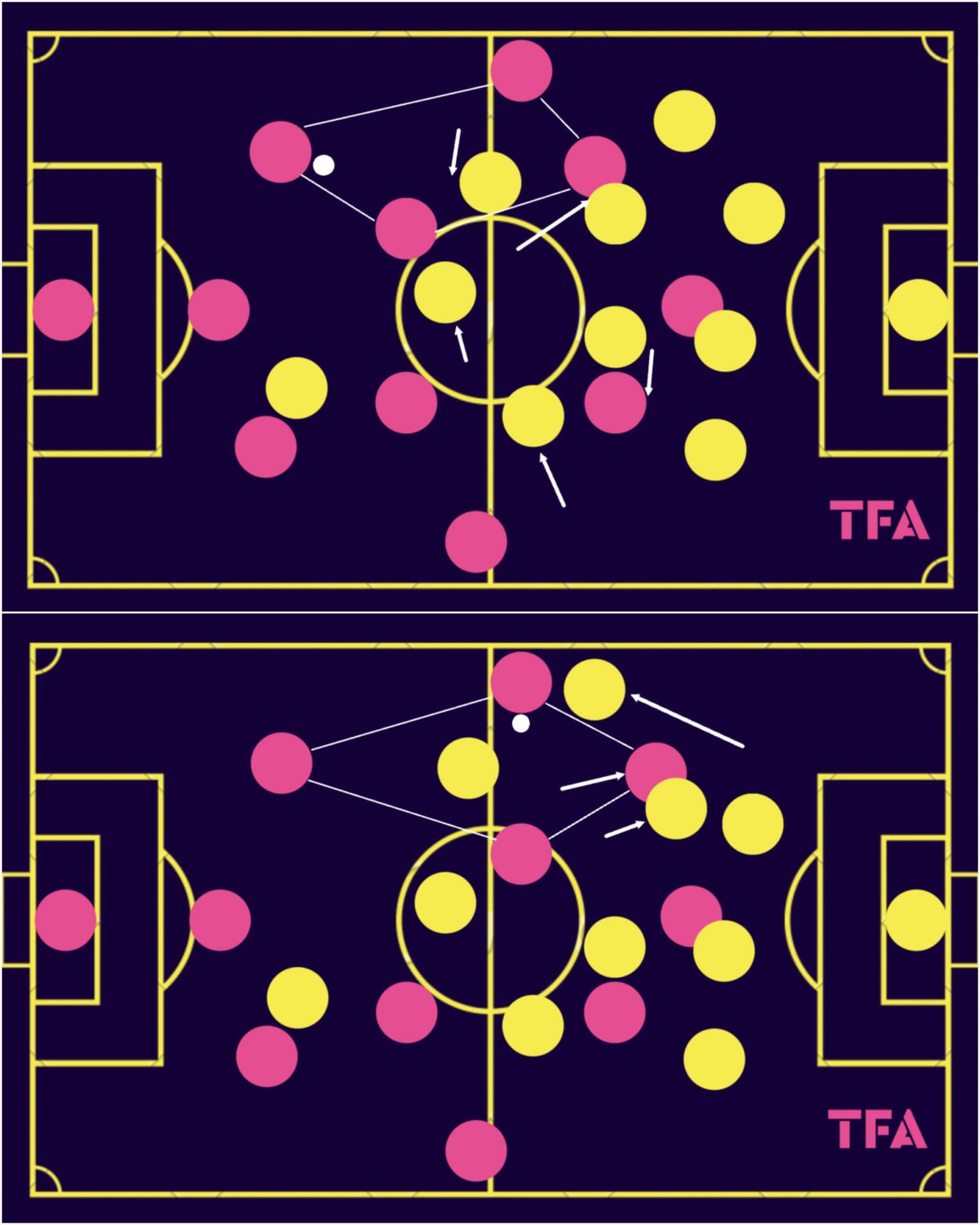
We have one example of Japan’s 3-4-3 in the ball progression phase here in figure 1, showcasing a Japanese attack from the fourth minute of the game. We can see how it and the players’ movements manipulated the opposition’s defensive structure and created problems.
Firstly, we can clearly see the wide diamond Japan’s structure creates in the top image. With the right-forward positioned dangerously in the half-space — and Zambia’s holding midfielder unable to mark the two Japan wide-forwards in these spaces between the lines — the Copper Queens’ right central midfielder drops, essentially getting pinned back to Japan’s wide forward. This forces the rest of Zambia’s midfield narrower. We saw this reoccur throughout the game.
This creates space out wide for the left wing-back to exploit. As she receives the ball, in the bottom half of figure 1, the Zambian right-back jumps out to press her, but this creates space behind for the right-forward to attack, which is the option the left wing-back takes on this occasion as she looks to help her side push into the final third.
Left wing-back Jun Endō of NWSL side Angel City was incredibly useful for Japan in this game. Her mix of passing and ball-carrying ability gave her team a varied attacking threat on the left, which made them even more difficult for the opposition to defend against. On this occasion, she attempted the through pass down the line for the wide forward; it was common to see her act as the wide playmaker driving balls forward from a slightly deep position like this — but it was also common to see her taking the opposition full-back on and dribbling into threatening areas.
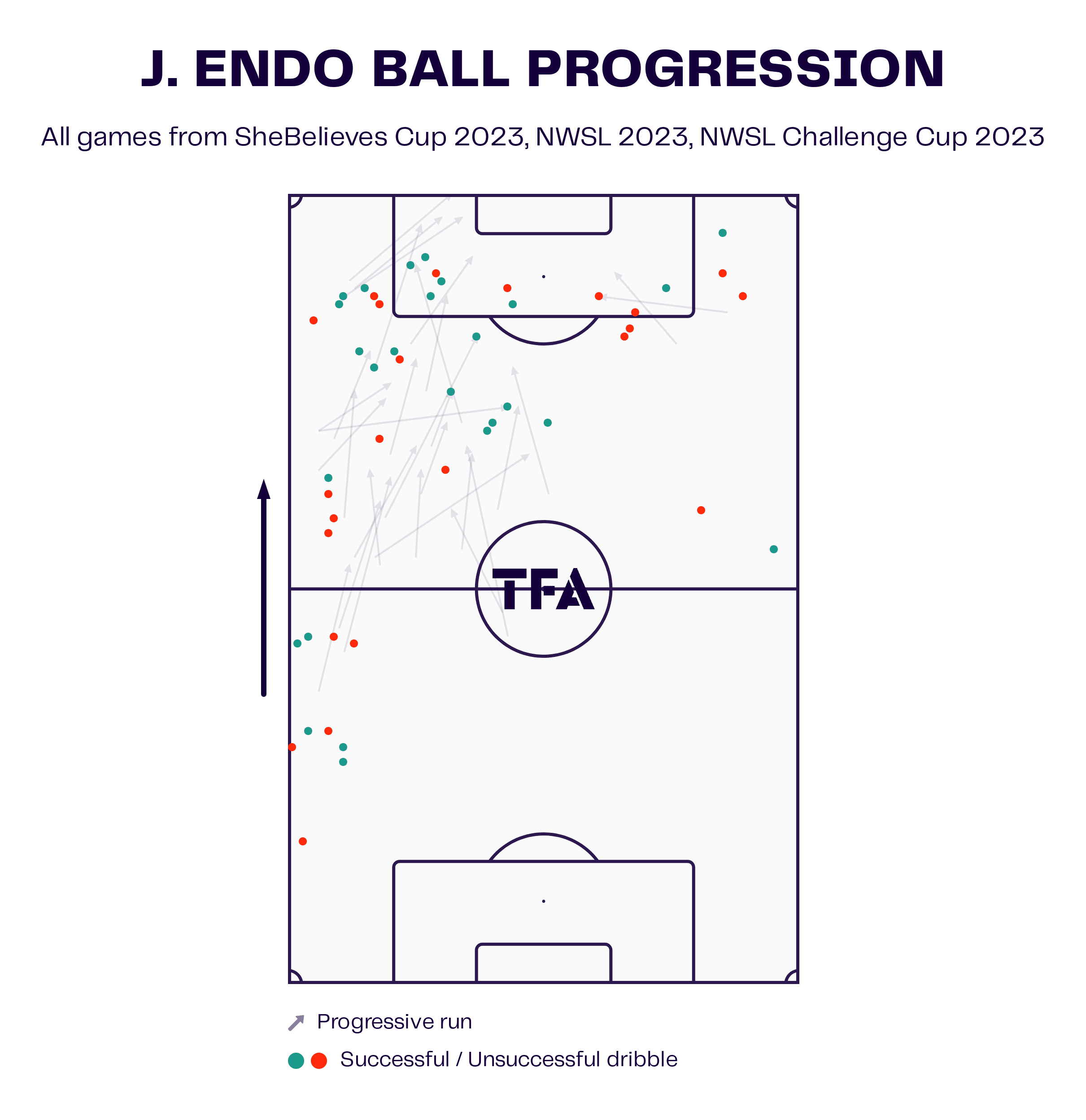
Endō’s dribbling is a crucial aspect of her game; we can see her ball progression map from 2023 here, which displays the areas she generally likes to carry the ball from. She’s especially active in the final third, but Japan will see plenty of her dribbling in and around the middle third too, with the role she plays in Ikeda’s side.
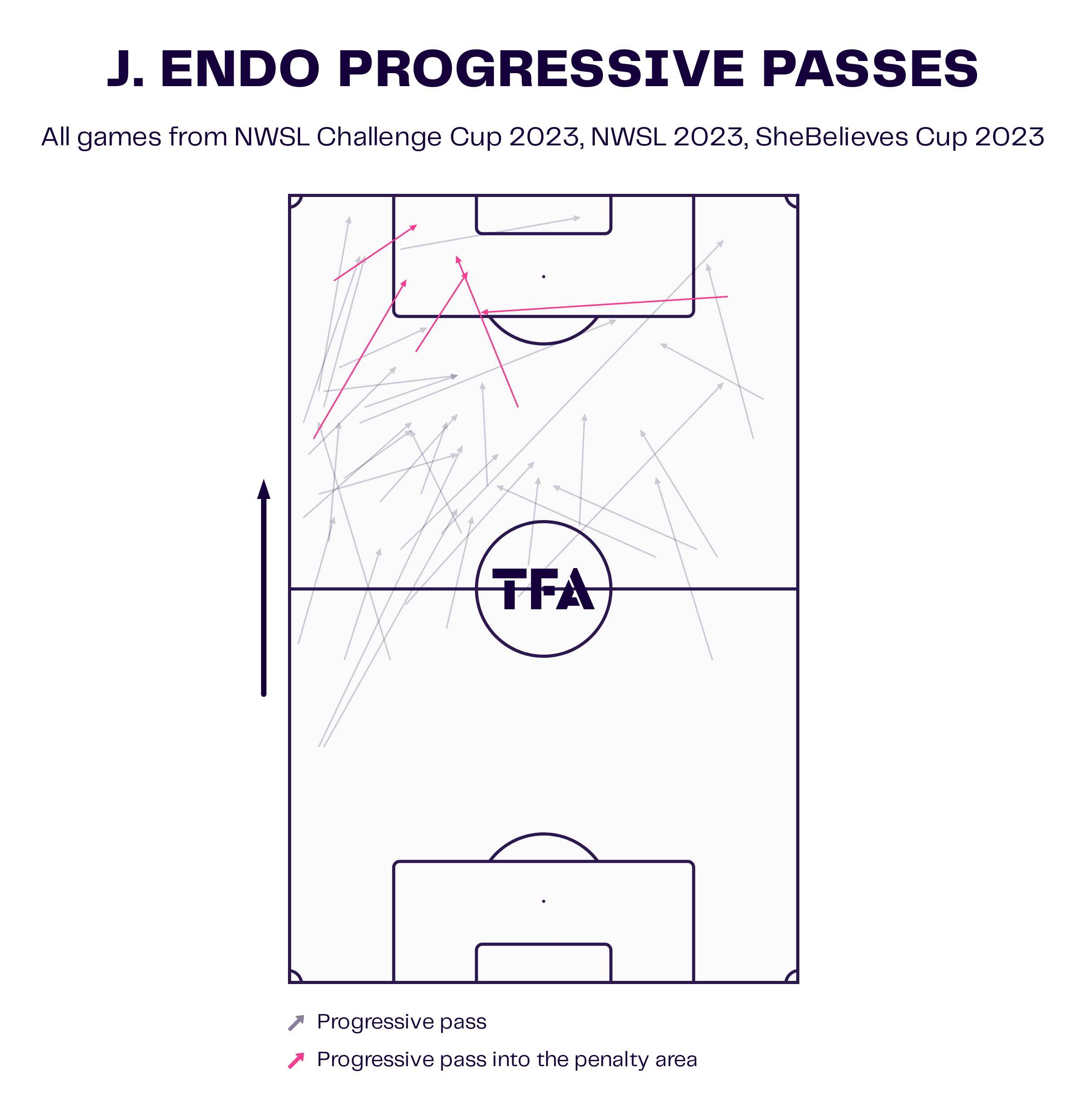
Furthermore, in figure 3, we have her progressive pass map from this year, showing from where she likes to play the ball forward and get her team moving into the final third. She’s got good vision and technical ability, making her a very dangerous playmaker from the wide areas where she’ll often have time and space to pick out her forward pass. Japan’s structure and movement should help her to generate plenty of final third entries in this tournament.
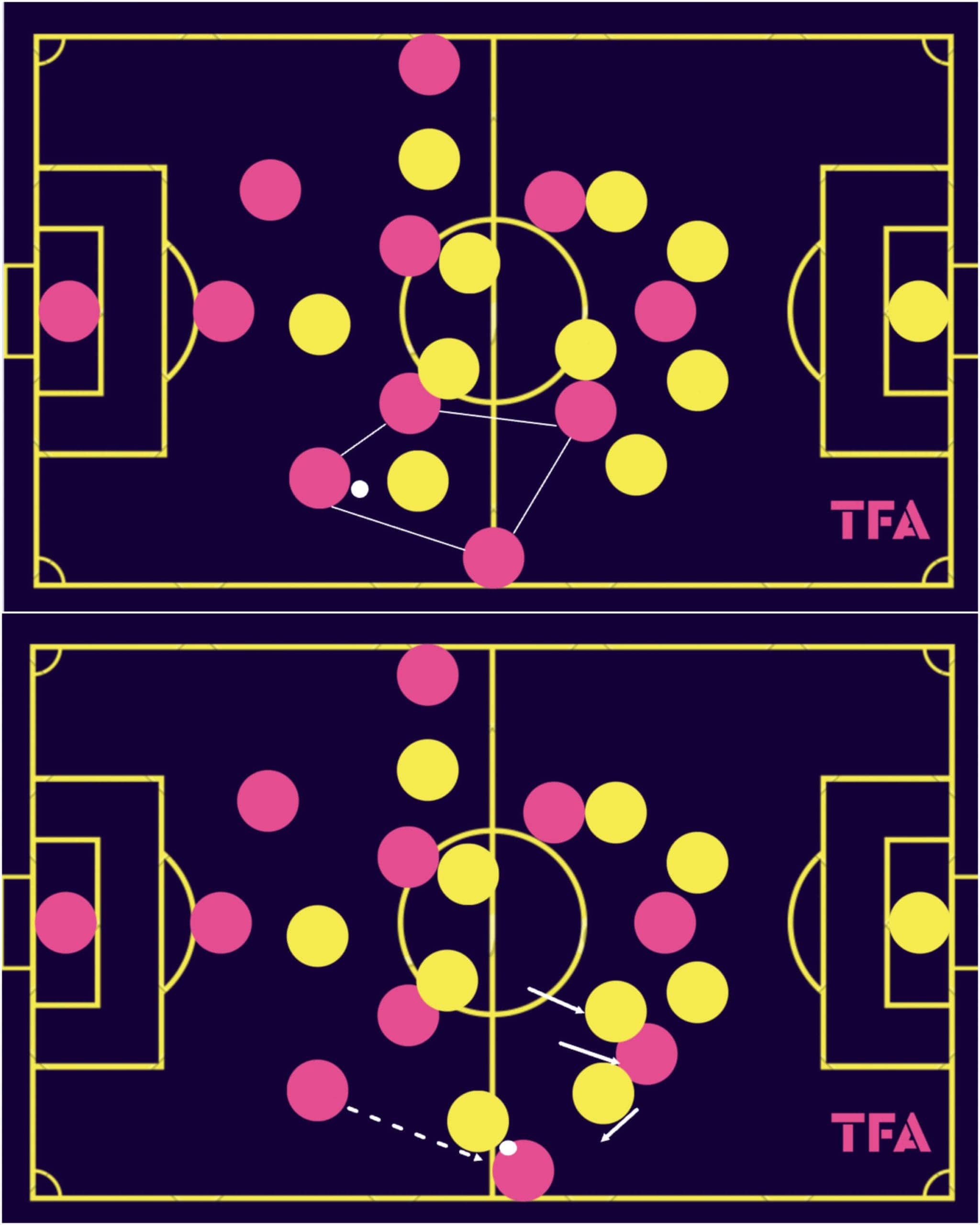
Figure 4 shows an example of the same structure on the right from this game. In this instance, the ball was again played out to the wing-back from the wide centre-back, drawing the opposition’s left-back out to press, which then triggered Japan’s wide forward to dart in behind, attacking the space opening up.
The holding midfielder is unable to track the run effectively. At the same time, the left-back cannot close the Japanese wing-back down quickly enough, allowing Japan to play the ball forward, in behind the defensive line, from the wide area here.
It’s a very similar attack to what had transpired just minutes earlier on the left, which is no accident. This exemplifies the structured attacking play and specific automatisms Ikeda ingrained in his Japan side. All opponents need to be aware of these parts of Japan’s game as this tournament progresses. They may know what Japan will do, but can they stop them from achieving success with the strategy?
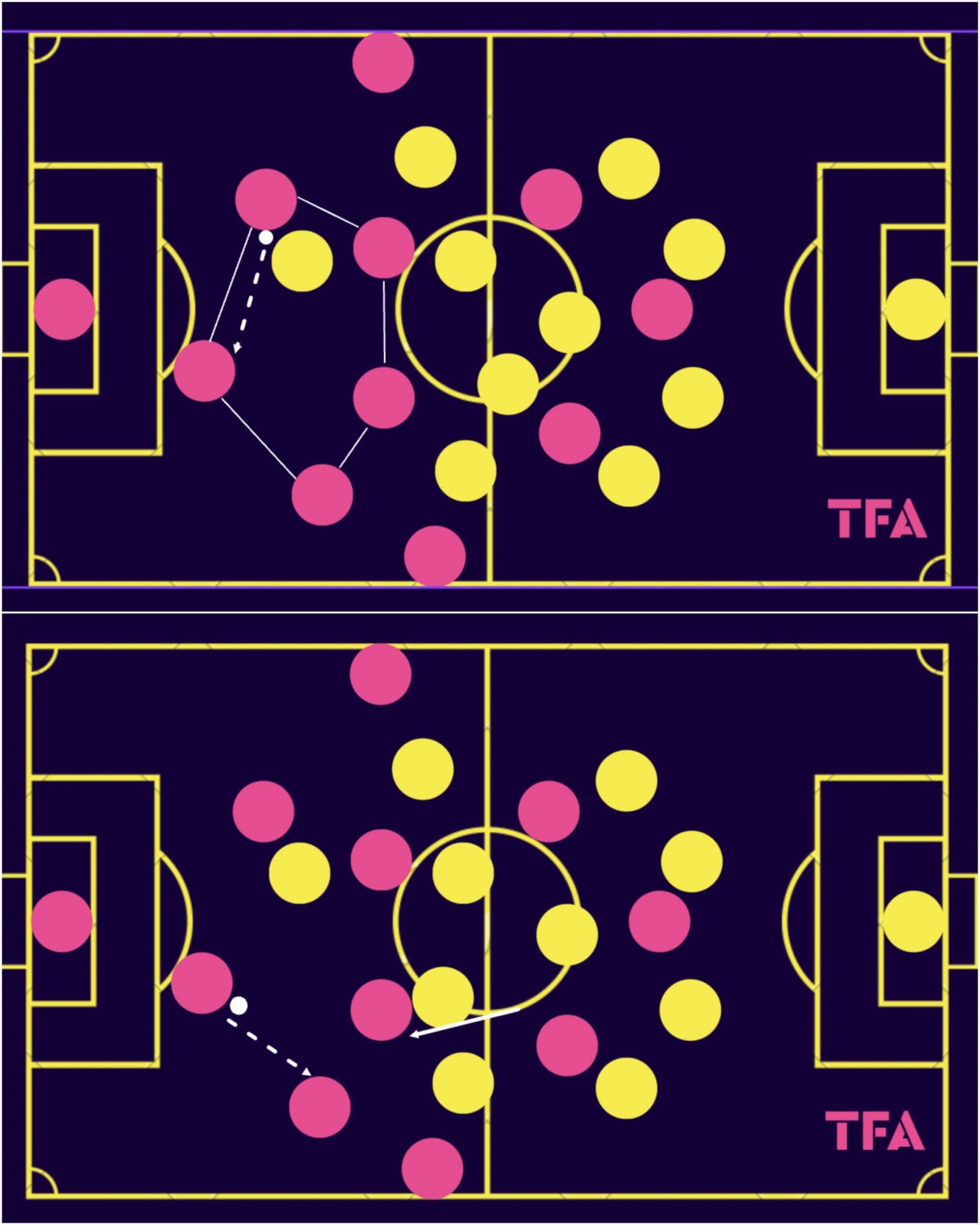
Barbra Banda led the Zambian press, and her job, a lot of the time, was quite a lonely one. Japan always build with a 3-2 base structure formed with their three centre-backs and two central midfielders. We see the pentagonal shape this resulted in at the base of their in-possession structure in the top image of figure 5.
Banda’s pressure was ineffective because while she was initially able to block the pass into midfield with her positioning between the ball carrier at left centre-back and the potential receiver in midfield, Japan were relatively easily able to play around her, with the pass going from the left centre-back to the central centre-back.
As the play progressed into the bottom image, we saw Zambia’s left central midfielder push up to get close to the Japanese right central midfielder — deterring Nadeshiko Japan from playing that ball.
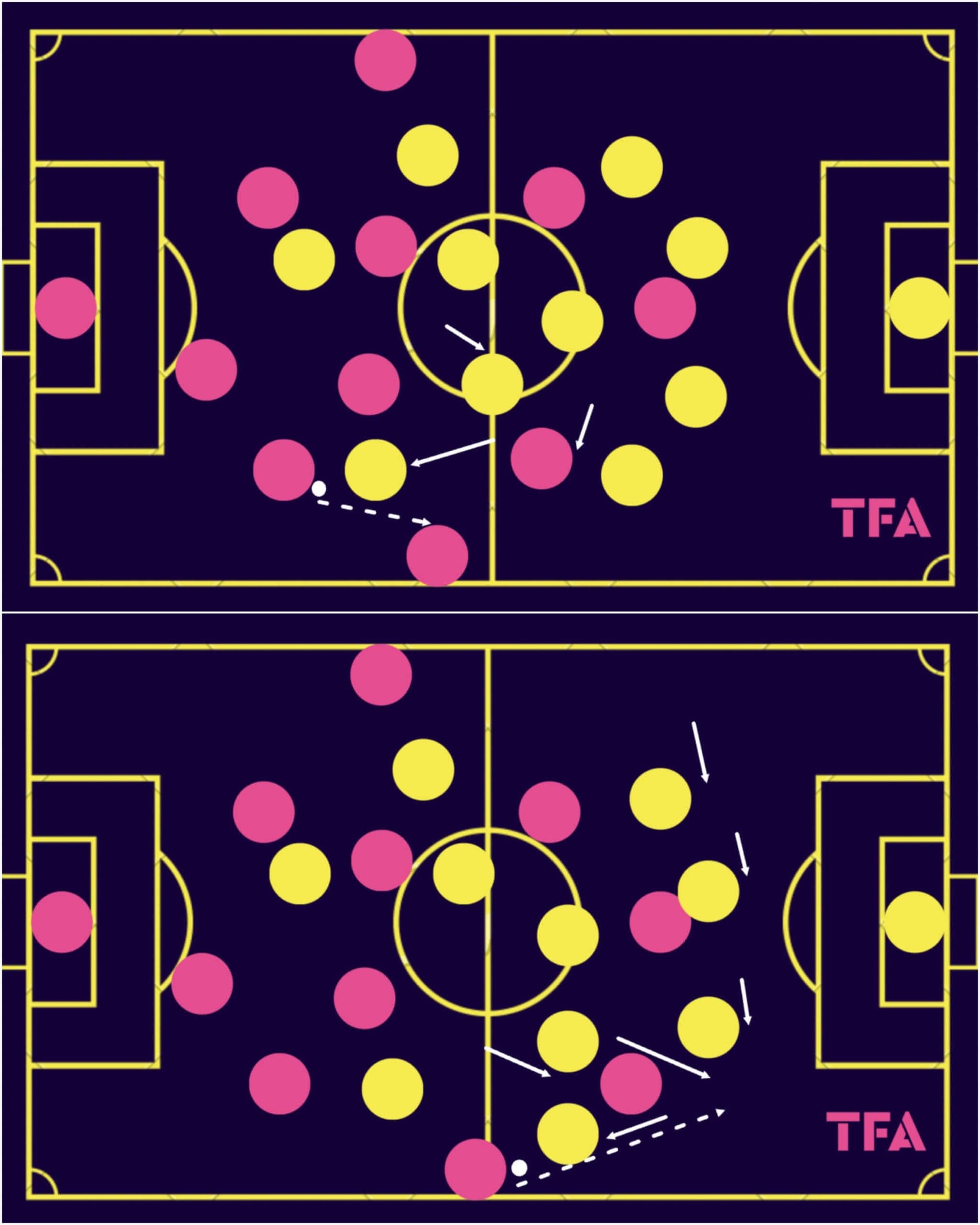
However, they kept playing around the press, ultimately making their way down the wing via the right wing-back, which again attracted pressure from the opposition’s left-back as she received out wide, creating an opportunity for the right-forward to burst in behind, finding her with a dangerous through ball.
With their quick passing and, again, the structure Ikeda and his coaching team put in place, Japan were able to manipulate Banda’s isolation at the front of the press, essentially just drawing her in, playing around her and tiring her out as her press never bore fruit.
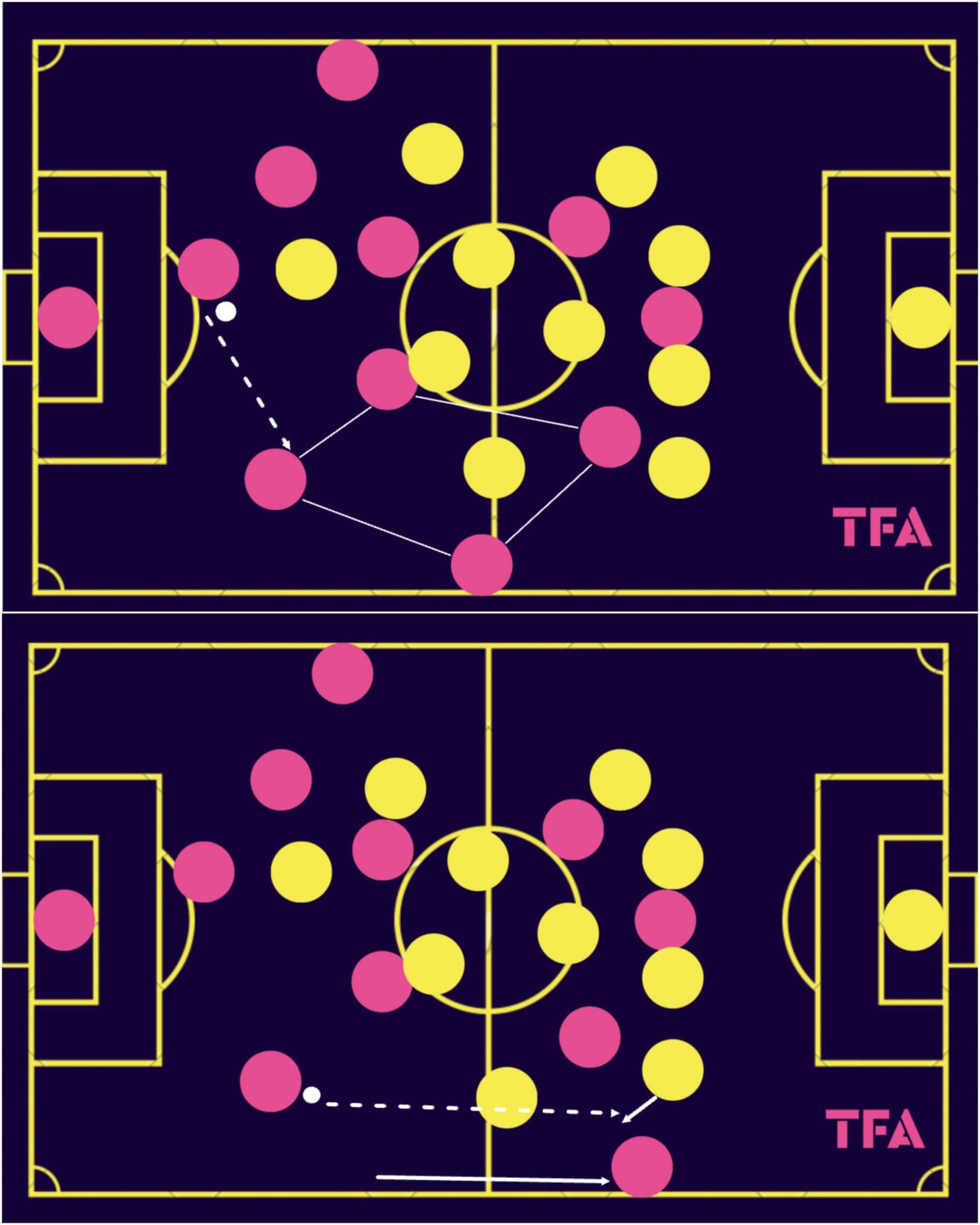
Movement from Japan’s wide forwards and wing-backs is crucial to their in-possession strategy’s success. When space is at a premium, and Japan are looking to build through the opposition carefully, their movements to come short provide valuable options to the deep central players.
These subtle but dangerous movements can also serve to manipulate the opposition’s press and create space for attackers, as we’ve seen in some of our previous examples.
At the same time, when the game is more open and more space is available, these players may look to go straight in behind, stretching the opposition and providing depth for their side.
We see an example of this in figure 7; as the ball is played to the right centre-back, the wing-back on that side sees an opportunity to dart in behind and get onto the end of the long ball over the top. Unfortunately, on this occasion, the pass is not accurate enough and ends up getting intercepted by the left-back, who steps out and regains possession for Zambia.
The movement, however, was ideal for what Japan wanted to achieve and demonstrated excellent thinking on behalf of the wing-back, who judged the situation well and made a good decision to give the centre-back an option for the long ball. With the pass being played more accurately, Ikeda’s side could’ve been straight in on goal here.
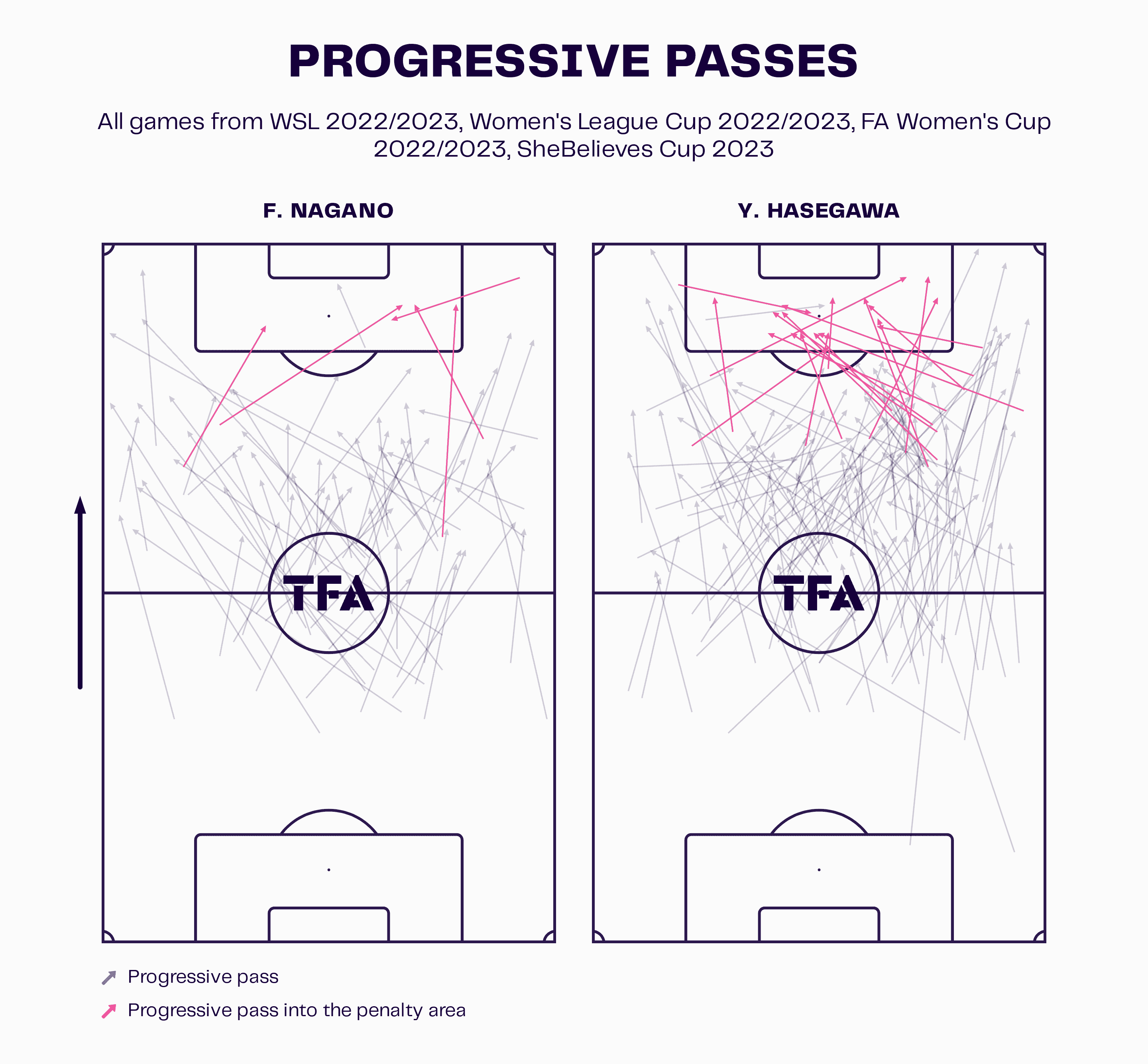
Two WSL players, Liverpool’s Fuka Nagano and Manchester City’s Yui Hasegawa, started in central midfield for Japan in this game. Above, we see their respective progressive pass maps from the 2022/23 campaign in all competitions.
Both players are very capable progressive passers, with Nagano making 5.91 per 90 in the league last season with 68.49% accuracy, while Hasegawa played 5.38 per 90 with an impressive 79.31% success.
The two were instrumental in deep midfield for Japan in this game, as they were afforded enough time and space to hurt the opposition far too often. This is why Japan’s attacks were often built through the midfield duo in their opening World Cup fixture.
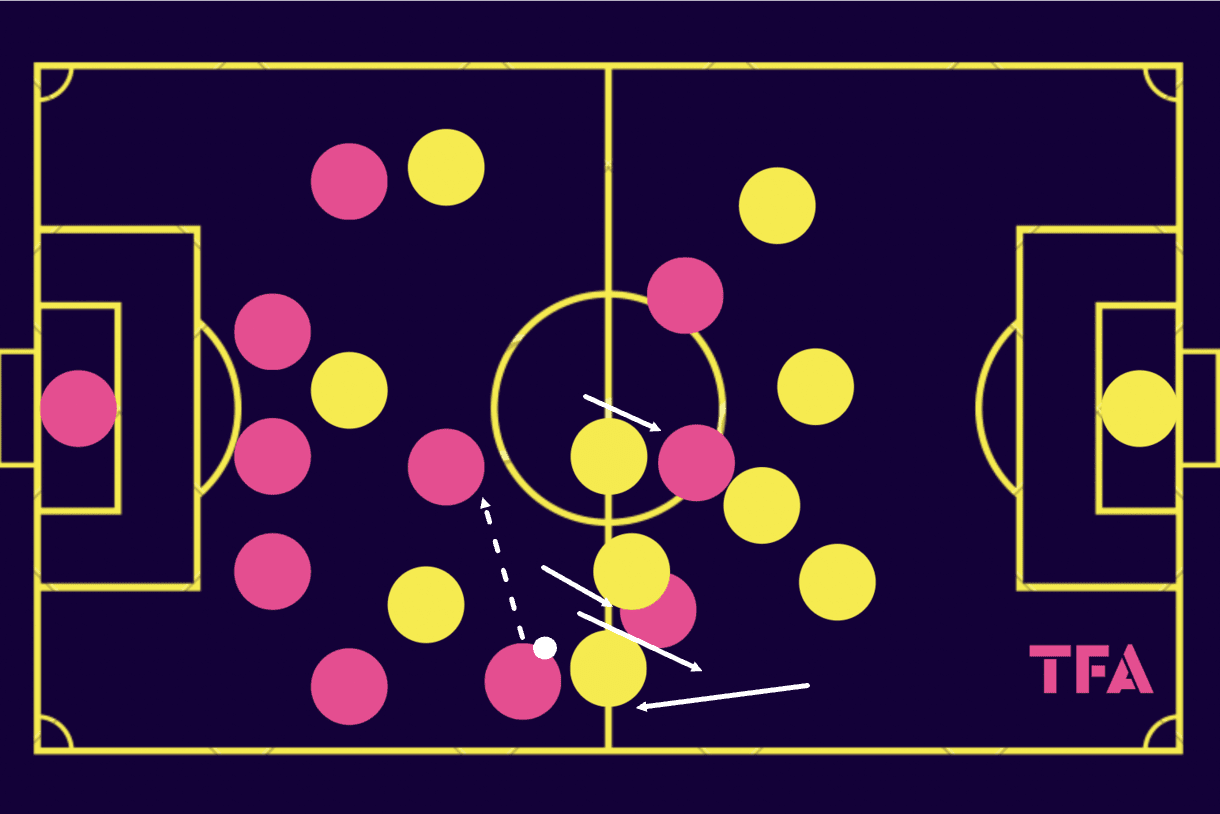
Figure 9 shows an example of one occasion, at around the 23rd-minute mark, when Nagano was able to receive in midfield with plenty of time and space to get her head up and decide on her next move.
This was a moment of transition, with Zambia having just lost out in an offensive duel, leading to Japan launching the ball up to the left-forward. However, mainly due to some intense opposition pressure, the forward was unable to turn and continue moving forward, so they played the ball back to the right wing-back out wide.
Again, the opposition full-back was drawn out of position here, but instead of targeting the space behind her this time, Japan instead passed the ball into the free central midfielder, who enjoyed lots of time and space to then get her head up and move the team forward from a valuable central position where you won’t often be afforded the luxury of extra scanning and decision-making time after receiving the ball.
Japan were especially lethal in transition in this game because of how they managed to create space for their central midfielders in this phase of play — initially playing the ball forward to an attacker who could hold it up, play it back and then see the ball get played into midfield in front of the Zambian defenders who’ll have just sprinted back and behind the forward line where the midfielders will have enough space to do some real damage to the opponent.
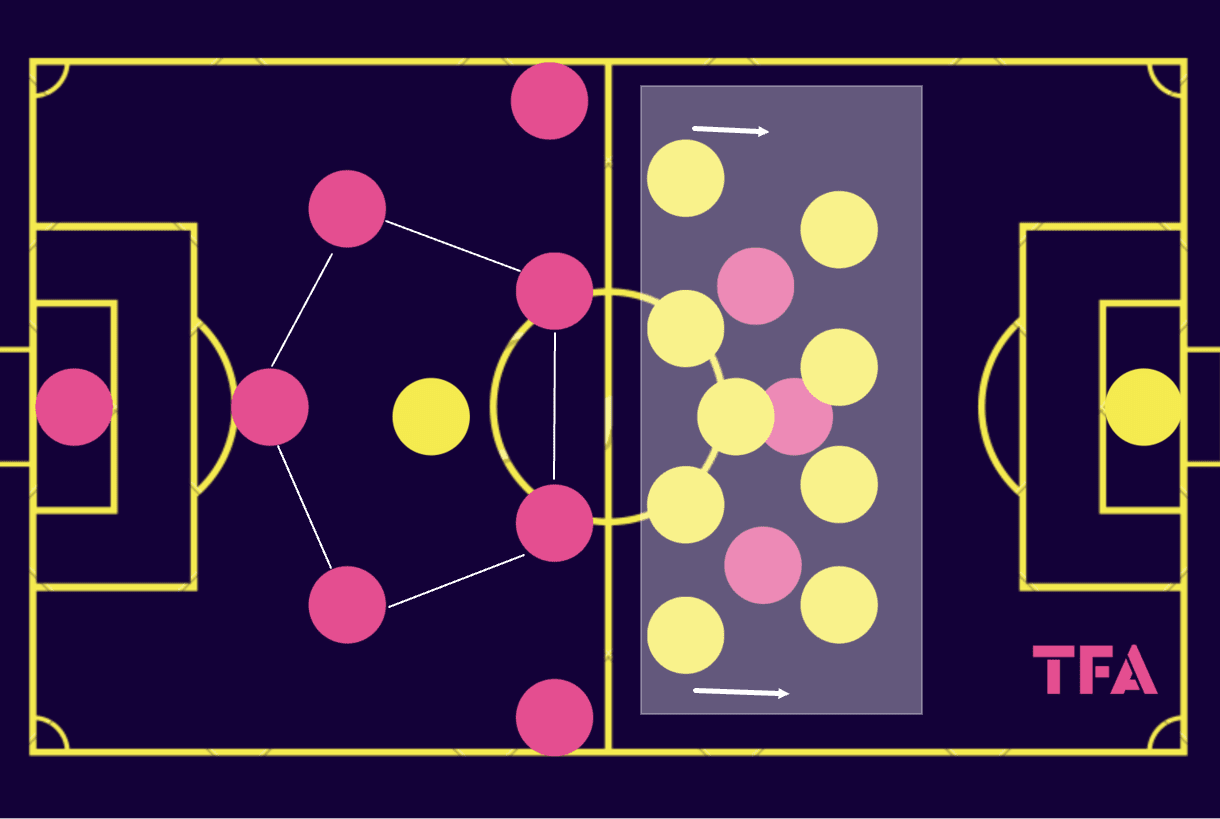
As the game progressed, the difference in conditioning between the two teams became a key factor. The Japanese players were far fitter than their Zambian counterparts, and this manifested itself in the speed at which the two teams played the game and, crucially, their success in 50/50 duels.
We also saw Zambia’s more tired players drop off without the ball a lot more as the game wore on. This could’ve partially been because of fatigue and partially to try and control the half-spaces where the wide forwards were wreaking havoc a bit better.
In any event, this simply served to create space for Japan’s deep midfielders in valuable central positions where they could receive in the progression phase time and time again, being allowed to turn and drive their team forward with incisive progressive passes.
The likes of Nagano and Hasegawa can’t be afforded this much time and space in valuable central areas — it’s just asking for trouble, and that’s exactly what Zambia received due to their deeper defending from about the 35th minute on.
This is a significant reason why Japan pelted Zambia’s goal with attempt after attempt as the game wore on and a warning for subsequent opponents not to make the same mistake or risk suffering the same fate.
Japan vs Costa Rica: Why was creating via the wings crucial?
So, now we’ve got a pretty good base knowledge of Japan’s in-possession approach from game one: what was similar/different in game two versus Costa Rica?
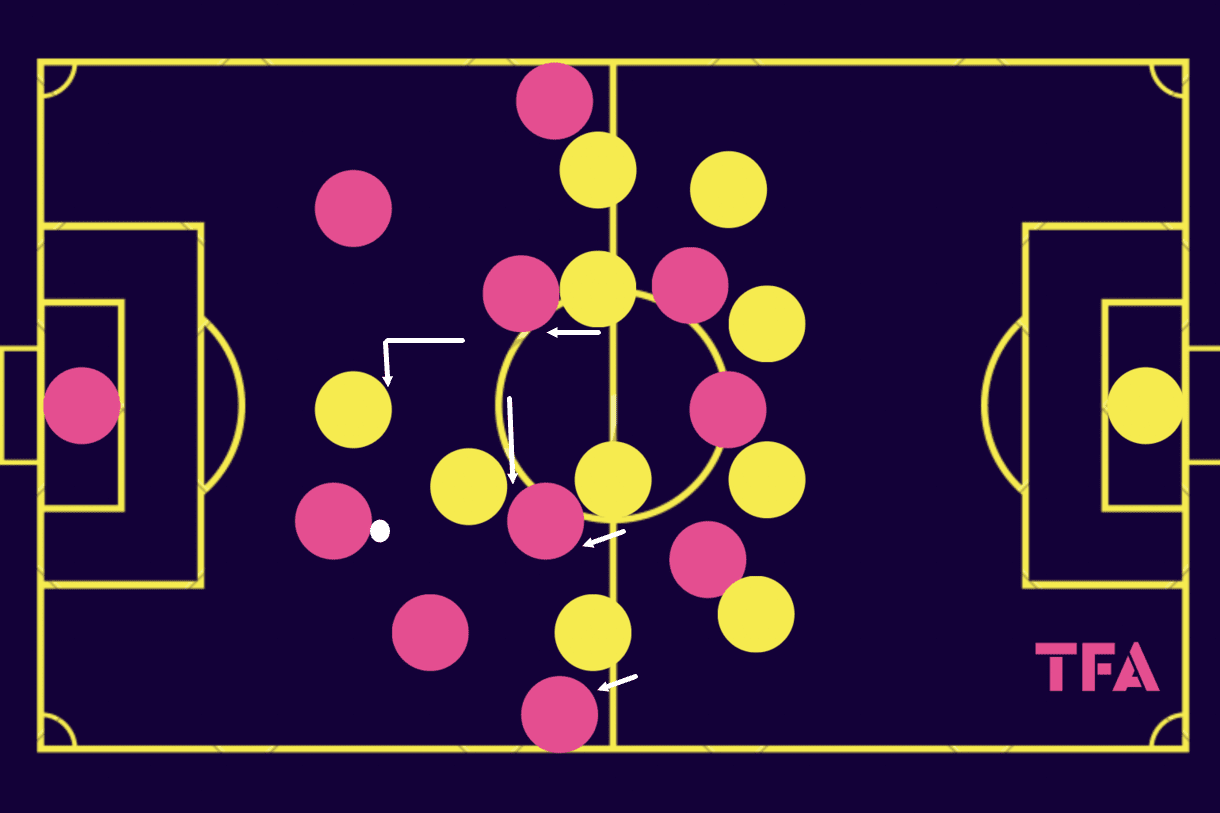
Well, while Japan once again lined up in a 3-4-3 shape, Costa Rica actually defended in a 4-4-1-1 in contrast to the 4-1-4-1 that Zambia played with. Furthermore, their pressing was a lot more active and aggressive throughout the match from the very first minute, meaning Japan went through the game less at the ‘leisurely stroll’ pace we witnessed in game one and with more of a sense of urgency as their opponents threatened to dispossess them in dangerous positions.
We see an example of Costa Rica’s press against Japan’s 3-4-3 in the build-up phase from this game in figure 11. One thing Costa Rica’s striker always ensured she did was cut off an easy passing angle before closing down the ball-carrier. Here, she cut off the pass to the left centre-back before closing down the central centre-back in possession.
Meanwhile, the ‘10’ behind her closed in on the nearest midfield passing option, while the ball-far central midfielder did the same on the opposite Japanese midfielder. This prevented Ikeda’s side from progressing forward through midfield as easily as they ended up doing versus Zambia in game one.
A common feature of this game, again in contrast to game one, is that Japan were forced to progress via the wing-backs a bit more often due to the lack of space afforded in central midfield.
They were still able to play into midfield at times — the access wasn’t completely cut off — but the time and space were severely limited, with Costa Rica pressing more effectively and aggressively, as well as cutting off passing lanes for midfielders a lot better, leading to some good interceptions of Japanese passes which created counterattacking opportunities for the opponent.
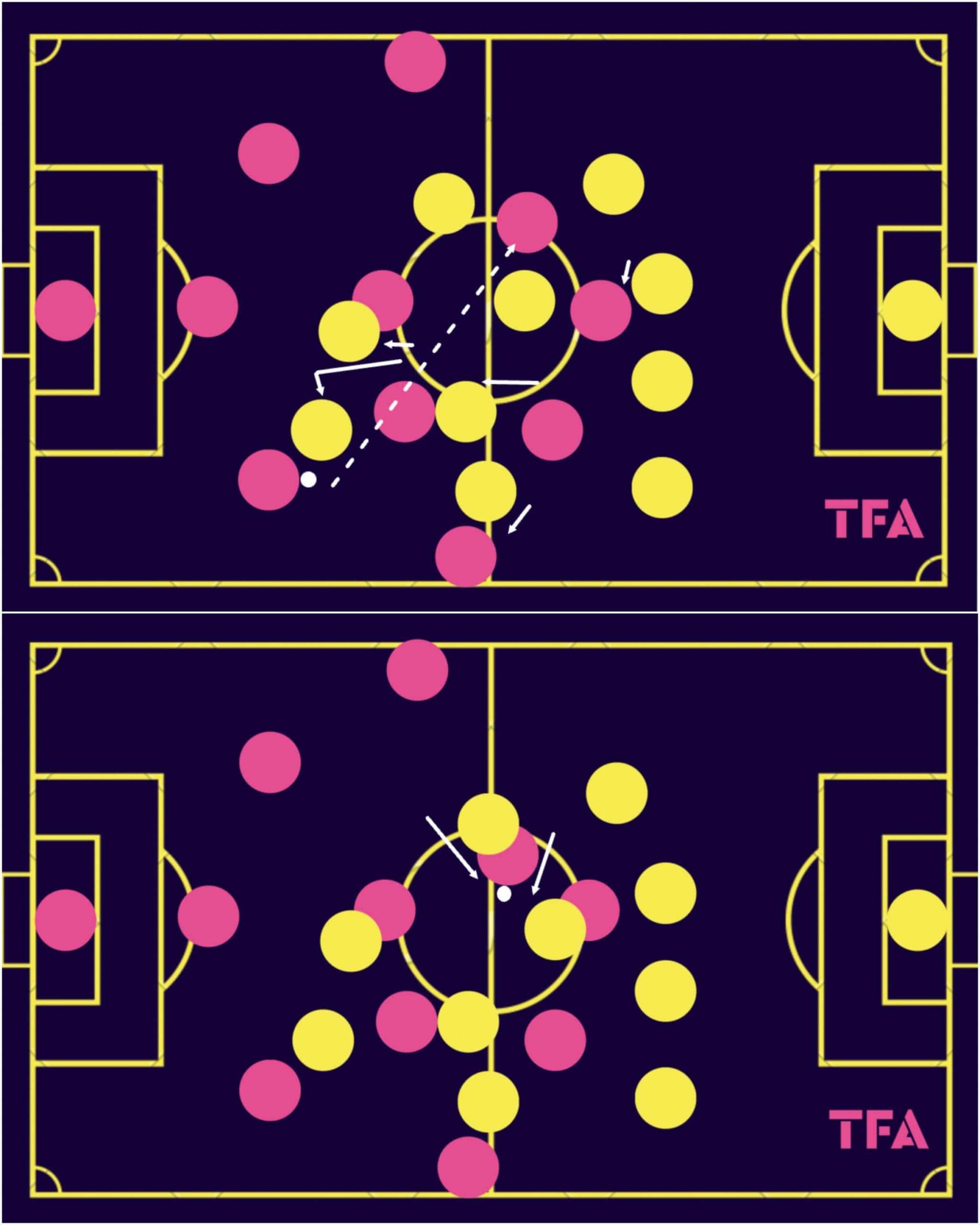
Japan were forced to play more long balls in this game, with space more limited in midfield, making the ball-carriers rush their decisions more and meaning that opportunities to play more carefully were not as available, so more long passing was inevitable.
In the case of figure 12 above, the opposition’s press has essentially cut off all short passing options for the ball carrier, forcing them into a longer ball. A typical long ball to see them try and play in this scenario throughout game two of the World Cup was from the wide centre-back to the wide forward on the opposite side (in this case, from the right centre-back to the left-forward, who was slightly free due to the opposition’s right central midfielder getting attracted to Japan’s centre-forward).
As the left-forward received, however, she was hunted down by the opposition’s right-winger, who diligently tracked back and ended up regaining possession for her side in the middle of the park, again creating a chance to counterattack.
It’s clear that as a result of space being more limited in critical areas due to the opposition’s pressing strategy in game two, Japan struggled to play through the pressure as much and faced a lot more adversity from a defensive standpoint in the form of opposition counterattacks due to more losses of possession.
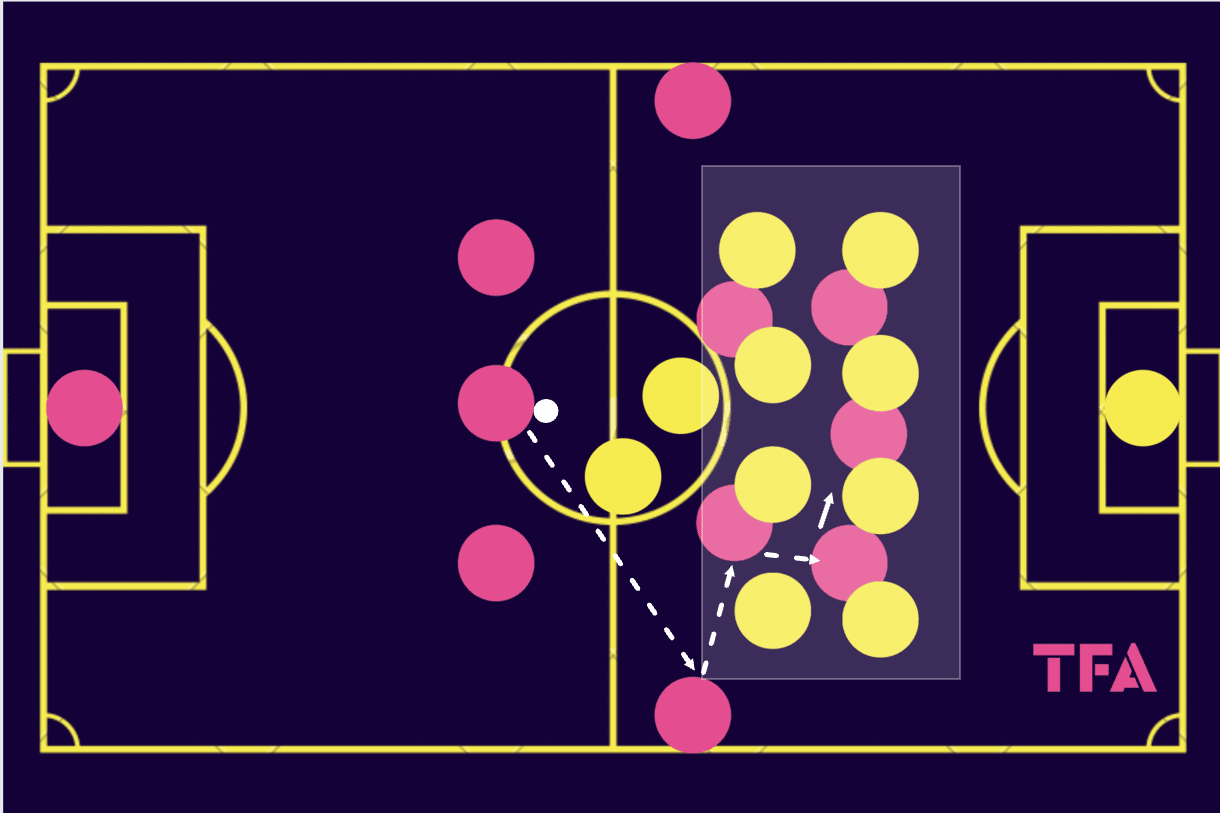
There were a couple of practical solutions Ikeda’s side deployed to work around this issue, the first of which saw Japan’s wing-backs play an even more crucial role in attacking phases.
Take figure 13, for example. Here, Costa Rica have set up in a very solid, textbook 4-4-1-1 mid-block that’s doing a great job of denying the Japanese the necessary space to progress through central areas.
As a result, the ball made its way directly from the centre-back to the wing-back, as was a common sight in this fixture. After playing to right wing-back Risa Shimizu of West Ham United, now the passing lane into central midfield is a bit more feasible; she takes the opportunity, plays into midfield and then the midfielder quickly passes the ball into the right forward’s feet in the half-space.
Even with space more limited than it usually was in game one, the right-forward can still take this opportunity to create a bit of havoc in the opposition’s structured defence, dribbling inside and running at the backline to create a goalscoring opportunity.
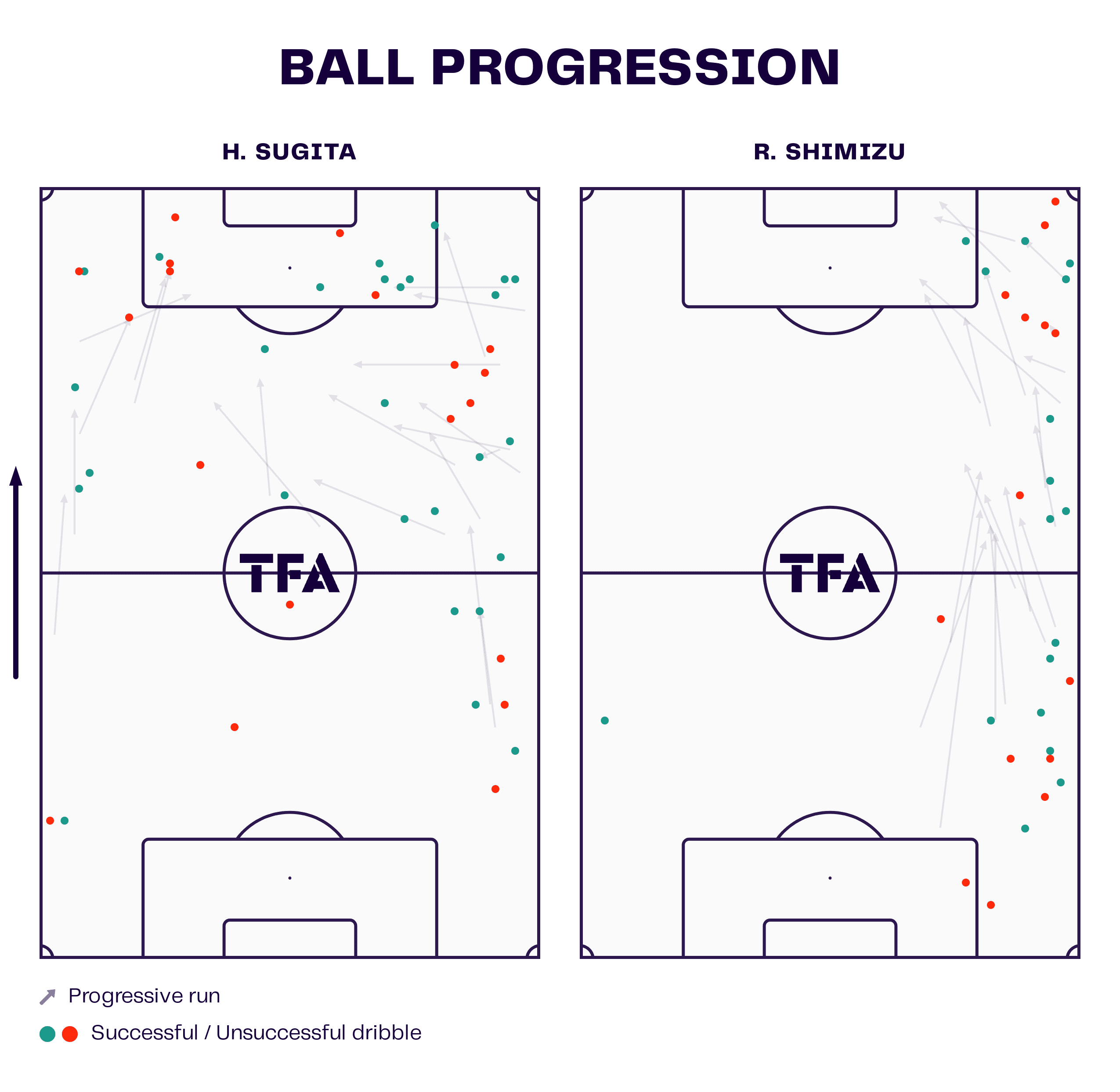
Along with being available as facilitators for getting the ball into central midfield, Shimizu and her opposite wing-back Hina Sugita of Portland Thorns — who normally plays on the right as the above image shows but was deployed on the left in this contest — acted as key ball progressors from a dribbling standpoint versus Costa Rica.
While Costa Rica’s collective defensive system was complicated to break down, they struggled a bit in 1v1 duels, which is somewhere that Japan’s individual quality could stand out a bit more.
With the wing-backs’ quality on the ball, along with the extra time and space they had out wide compared to central positions, this ended up being a crucial part of Nadeshiko Japan’s ball progression and chance creation in this fixture as they searched for ways to open up the opposition.
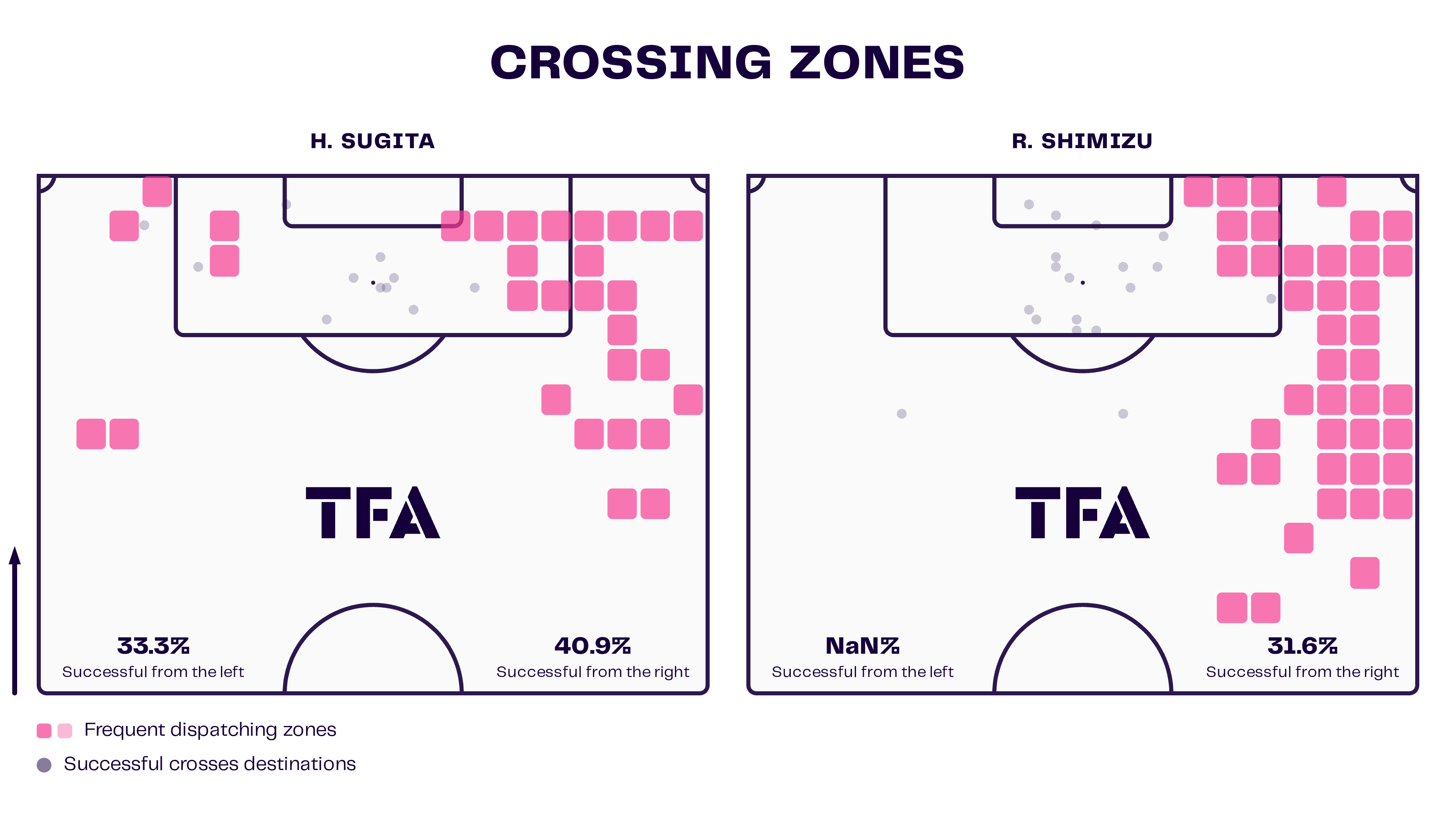
Shimizu is very comfortable crossing from deeper areas which is a trait she put to good use versus Costa Rica. She frequently floated the ball into the box via quite early crosses, looking to create some chaos in the box for her forwards to capitalise on and find a way of progressing into the penalty area, with it proving difficult for Ikeda’s side to work the ball into high-value positions carefully a lot of the time.
Sugita, on the other hand, crosses more from advanced areas, though occasionally sends balls in from deep too.
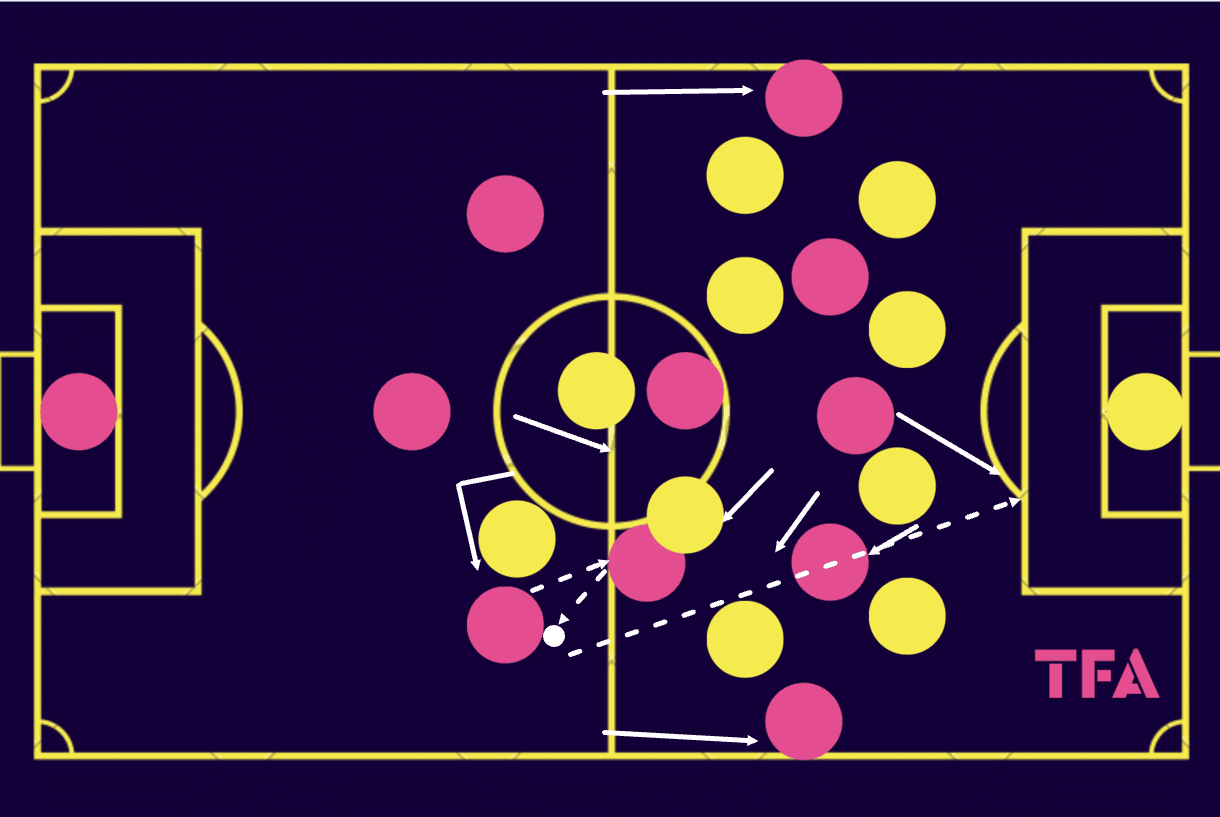
The other common way in which Japan created significant problems for their opponents in this game was via direct play — long balls over the top were more common in this one than in the previous fixture.
In figure 16, for instance, the right centre-back quickly plays the ball back and forth with the right central midfielder, who attracts intense pressure from behind after the centre-back initially sends her the ball.
We see the wide diamond from game one here a little bit too, and as Japan’s left-forward drops into the half-space to create a passing option for the deeper teammate, Costa Rica’s left centre-back actually steps up a bit, creating space in behind for the centre-forward to attack.
Spotting this opportunity to exploit the space in behind, Japan’s right centre-back drills the ball over the top for the forward to chase, and while it doesn’t directly lead to a shot, it does allow Japan to effectively enter the final third and attack Costa Rica from an even more dangerous position, representing a positive of this attack.
We saw Japan play the ball forward in a direct fashion like this, hold it up and then send it out wide quite frequently in this contest. More time and space was simply available in the wider areas in all phases of attacking play, meaning Nadeshiko Japan built through the wings quite a lot and attempted to enter the box via the wings quite a lot, either with crosses or dribbles.
Both of Japan’s goals in this game came from slightly wider positions, highlighting firstly, how well Japan exploited the wings in game two and secondly, how well Costa Rica did, compared to Zambia, in limiting Japan’s access to the central positions.
Japan vs Spain: What to expect?
So, with all of this said, how can we expect the Japan vs Spain game to go? This will undoubtedly be Japan’s most challenging game of the tournament so far, with Spain representing a far stronger outfit than either of the previous two opponents.
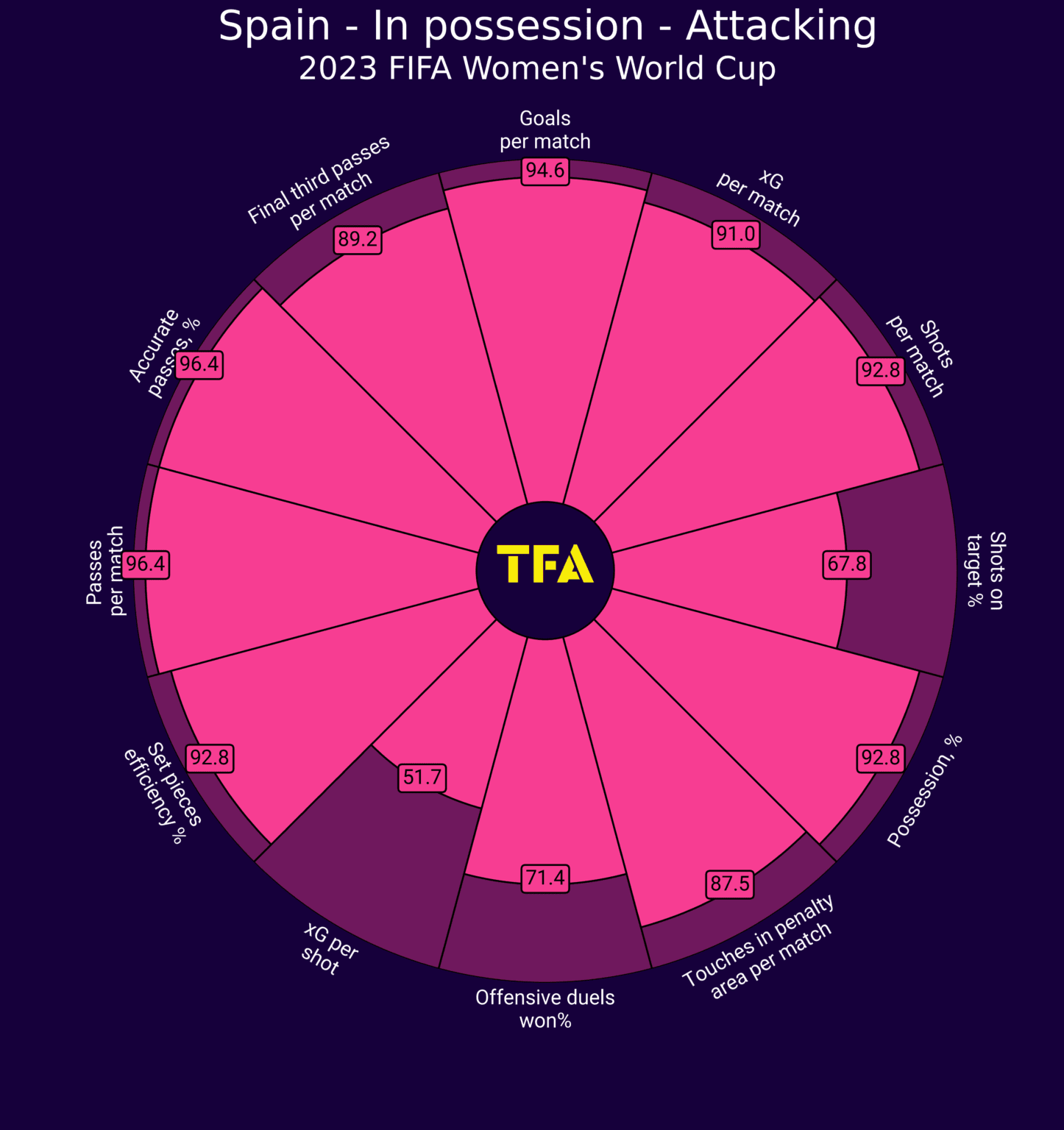
As we discussed in our pre-tournament tactical preview of Jorge Vilda’s side, Spain will look to dominate the ball, giving Japan a contest for possession. They are good at creating goalscoring chances and will give Ikeda’s defence and goalkeeper a much bigger test that they must be prepared for.
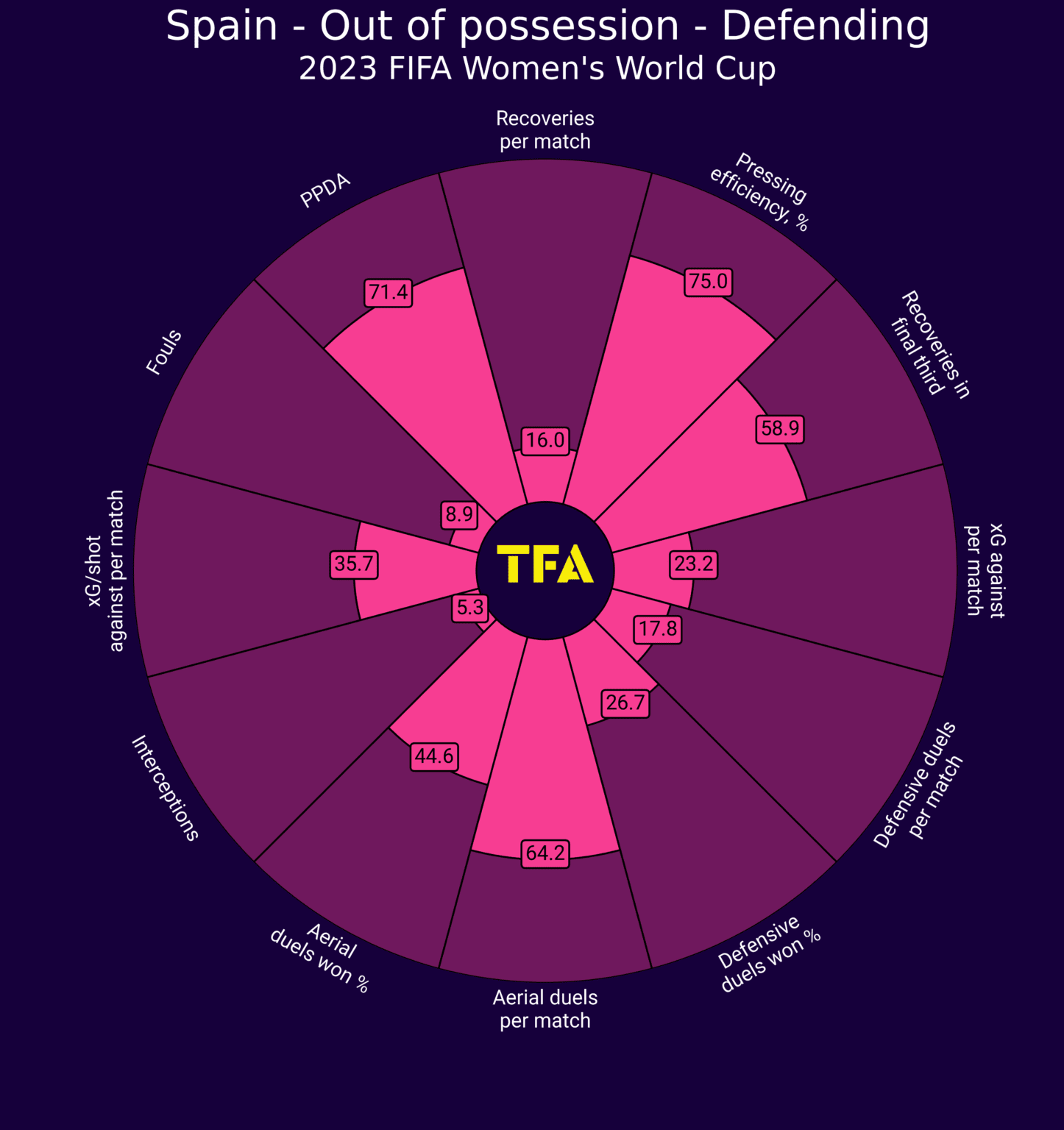
Without the ball, however, while Spain are decent in terms of pressing efficiency, they aren’t the most threatening side and could find it difficult to cope with Japan’s automatisms and movement.
What has made Japan’s possession game so strong and, thus, Japan so tricky to play against is the multiple ways in which they can hurt you. While much of their possession play is very structured, it gives receivers many options for what to do with the ball.
For instance, in game one, as Endō received out wide, she usually had a choice of playing a killer through ball, passing into the spacious midfield area or taking the full-back on herself and trying to carry into the final third. This is just one example with one position — a position that’s sure to be vital in the game versus Spain — but Japan present this threat all over the attack and midfield, with the wide forwards and wing-backs, in particular, representing a real multifaceted threat.
The midfielders, if given time and space, are very well capable of producing plenty of goalscoring chances, as we saw in game one. Vilda will know his side must deny Japan this space in central midfield and try to control the midfield duo much more than Zambia did.
However, by pushing up onto the midfielders more aggressively, Spain will leave greater space for Japan’s wide forwards to try and exploit behind the Spanish midfield line by dropping in those half-spaces, the wing-backs will be brought into play more, making their threat a very prominent one and we can expect to see Japan present the direct threat to Spain’s defensive line as well; this created plenty of problems for Costa Rica in game two as they quickly got the ball into the final third, holding it up before playing it out wide and taking advantage of the space there.
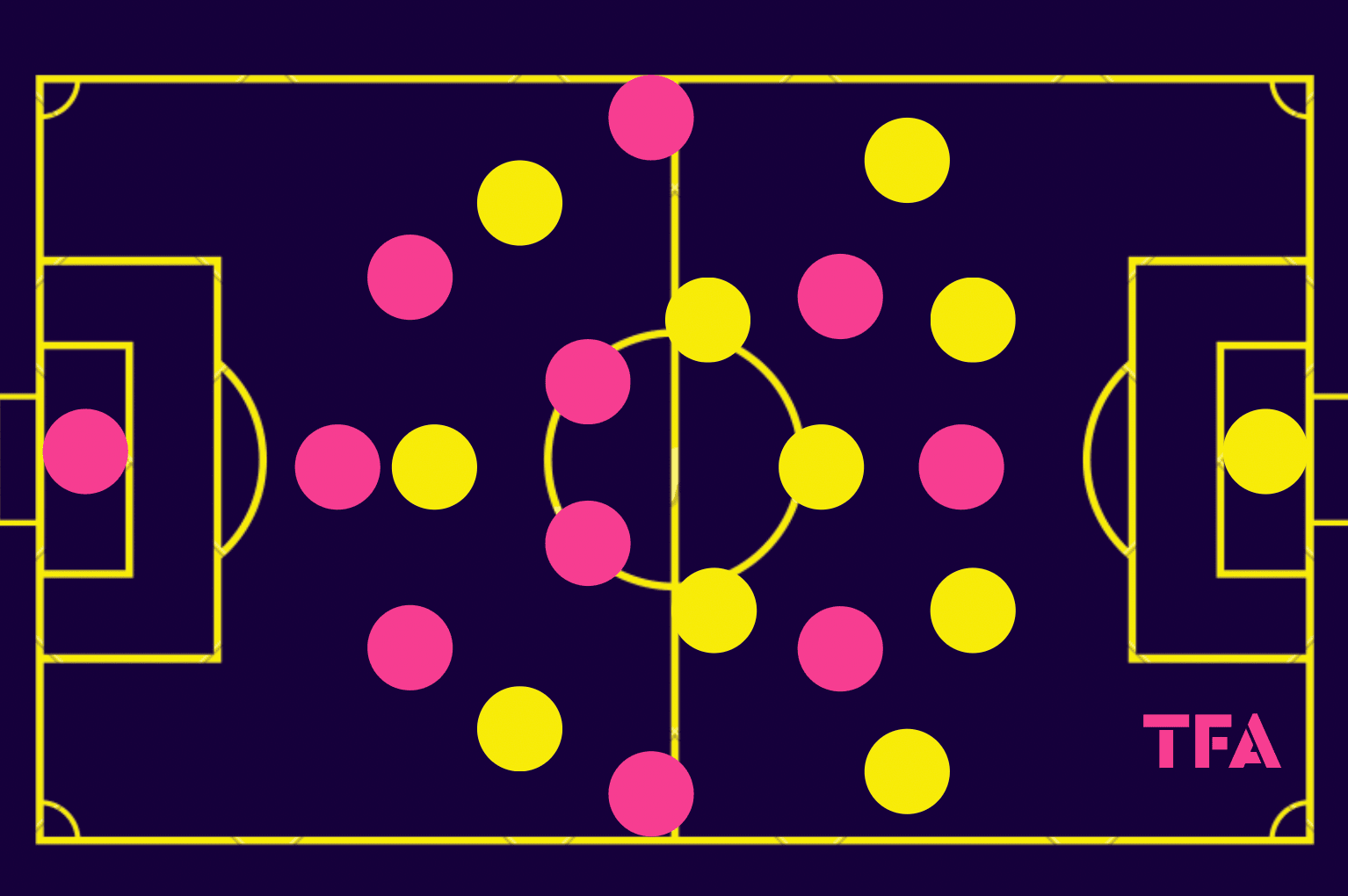
Japan will line up in a 3-4-3 shape for their final game, as they did in games one and two, as they seem fairly married to this system Ikeda has implemented — and why not? It’s working well so far!
Meanwhile, Spain will likely set up in their typical 4-3-3 shape and present another new challenge for Japan’s attack with a different defensive style than they’ve come up against so far in this tournament.
Expect Japan’s wide diamonds to be a vital feature of this game. If their automatisms in these areas come off, they’ll break through Spain, create overloads out wide or in the half-space areas and generate goalscoring opportunities.
Spain must be very well organised without the ball, with players knowing their roles and how they need to react to the Japanese plays like the back of their hand in order to quickly react to the fast-paced passing Ikeda’s side can threaten them with.
Anticipate seeing the face off we’ve created in figure 19 at some points of the match, though of course, this is a very basic example of how the teams will shape up, which will change as the ball moves about, altering the specific dynamics of the engagement.
If Spain can cut off Japan’s access to the final third, pin them back and generate turnovers high up the pitch, they will be in good shape, but doing that is much easier said than done, as Japan’s wing-backs will push forward to create a front-five that overloads the Spanish backline while the wide diamonds also create wide overloads that can help Japan to progress to the final third, so Spain’s defensive approach and organisation will be crucial in this battle.
Conclusion
In conclusion, we hope we’ve effectively demonstrated why Japan have been one of the strongest and most interesting teams to watch, for us, at the World Cup so far from an in-possession standpoint due to the effectiveness of their highly-structured possession play.
Vilda’s side will pose the greatest threat to the success of this approach of any side thus far. Their success or failure in denying Japan enough access to the final third to generate lots of goalscoring opportunities as they did in the opening two games will be a great indicator as to whether or not Ikeda has come up with a formula for his team to take World Cup number two back home or if they’ll need to present even more against the biggest teams.
For us, Japan have a good chance of hurting Spain on the ball, though I’d also say the same vice versa. Both teams will present a significant threat to the other with possession, and I’d expect this to be a real contender for game of the group stage, but let’s see!




Comments